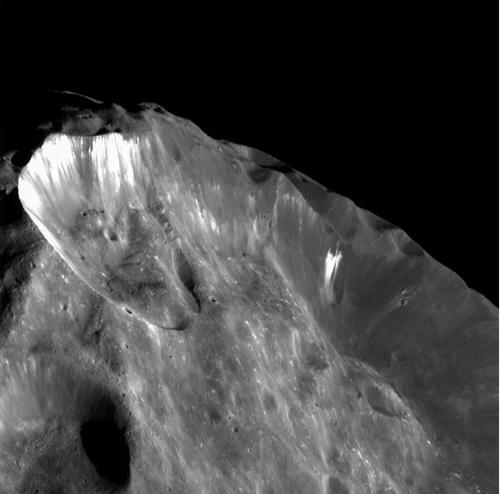Hallo Cosmo,
2. Gibt es bereits eine Erklärung für die andere (bläuliche) Farbe des Auswurfmaterials rings um Stickney? Ist dies vielleicht die Originalfarbe von Phobos (die ältere Oberfläche könnte durch Spaceweathering "Farbe" bekommen haben)? Oder ist dies Material des Einschlagobjekts?
Ich habe dazu
hier folgendes gefunden:
The color data accentuate details not apparent in black-and-white images. For example, materials near the rim of Stickney appear bluer than the rest of Phobos. Based on analogy with materials on our own moon, this could mean this surface is fresher, and therefore younger, than other parts of Phobos. Man vermutet dass, ähnlich wie es bei unserem Mond aussieht, die Oberfläche an diesen Stellen jünger als an anderen Stellen von Phobos ist.
3. Gibt es Erklärungen für die ganzen Linien auf der Oberfläche, welche auch noch nahezu parallel angeordnet sind? Vor allem die "Perlenschnüre" (dutzende Krater in einer Reihe) sehen beeindruckend aus.
Ich habe ähnliche Muster auch schon bei manchen Saturnmonden (z.B. Phoebe) gesehen:

Saturnmond Phoebe (Foto: NASA/JPL/Space Science Institute)
In der
Bildbeschreibung steht:
Images like this one, showing bright wispy streaks thought to be ice revealed by subsidence of crater walls, are leading to the view that Phoebe is an ice-rich body overlain with a thin layer of dark material. Obvious down slope motion of material occurring along the walls of the major craters in this image is the cause for the bright streaks, which are over-exposed here. Significant slumping has occurred along the crater wall at top left.
The slumping of material might have occurred by a small projectile punching into the steep slope of the wall of a pre-existing larger crater. Another possibility is that the material collapsed when triggered by another impact elsewhere on Phoebe. Note that the bright, exposed areas of ice are not very uniform along the wall. Small craters are exposing bright material on the hummocky floor of the larger crater. Auf Deutsch zusammengefasst: Man vermutet, dass diese hellen Streifen auf Phoebe, die offensichtlich aus Eis bestehen, entstanden sind, weil die Schicht, die darüber lag, am Kraterhang hinuntergerutscht ist. Der Auslöser dafür könnten Einschläge von kleinen Objekten auf den betreffenden Hängen oder Einschläge von größeren Objekten auf anderen Stellen von Phoebe sein.
Ich kann mir gut vorstellen, dass das auf Phobos ähnlich ist. Ein Hinweis darauf findet sich auch noch auf der Bildbeschreibung eines anderen MRO-Bilds von Phobos:
The lineated textures on the walls of Stickney and other large craters are landslides formed from materials falling into the crater interiors in the weak Phobos gravity (less than one one-thousandth of the gravity on Earth). (
Quelle)
Ich hoffe, ich konnte damit wenigstens einen Teil der Fragen beantworten oder neue Anhaltspunkte geben.
Mary
